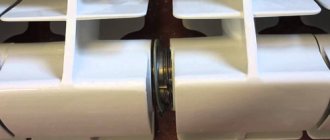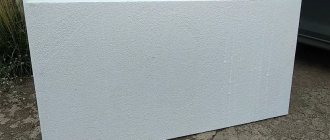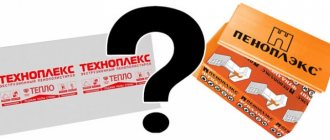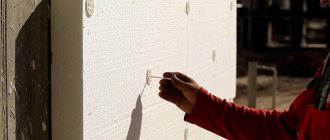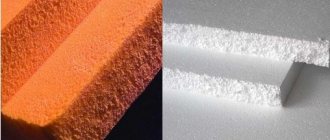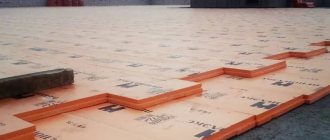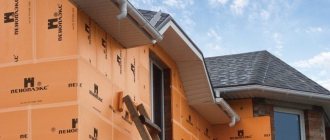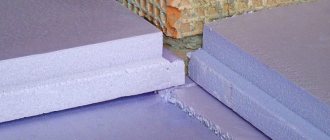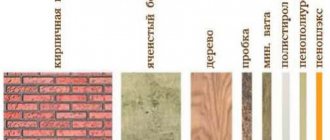Selecting adhesive for extruded polystyrene foam.
Extruded polystyrene foam is a reliable insulation material for walls, facades, floors, and ceilings; it is often used in construction. Penoplex is a capricious material, and not every glue is suitable for it: some adhesives can destroy the structure of extruded polystyrene foam. Choosing the right adhesive for extruded polystyrene foam will help you quickly and reliably repair your home. Today we will introduce you to the features of extruded polystyrene foam and tell you why it is considered the best insulation for houses.
We will also advise how to glue extruded polystyrene foam.
Selecting adhesive for extruded polystyrene foam
How to glue polystyrene foam?
To fasten the slabs, you can use different means that have different components. But there are specifics to using mixtures. So, it is better to use one for gluing to a concrete base, another for attaching to a brick wall, and another for winter work. There are adhesives that combine the properties of fastening material and insulation and have low thermal conductivity. Before purchasing, it is important to clarify that the product contains no substances that corrode polystyrene foam. This:
- acetone,
- alcohol substitutes,
- toluene,
- ethers,
- other solvents.
The ideal option is to purchase specialized formulations, because their manufacturers have already taken into account all the important points. There are three main types of products that are suitable for gluing material. This is a plaster-adhesive mixture of different brands, polymer adhesives and bitumen glue (mastic).
People often use “liquid nails” in a bottle, silicone sealants, frost-resistant tile adhesives, drywall and tile products for gluing materials. Can I use them? Experts say that the use of such adhesives is possible, especially if additional fastening of the structure with dowels is planned. But the cost of the work can be much higher, so it is better to buy products designed for XPS.
Gluing polystyrene: with a piece of polystyrene, wood, metal
Today, polystyrene has become quite entrenched in people’s everyday lives. This material is especially often mentioned by summer residents and those who are planning to build their own house - it is necessary to protect the home from the cold and get rid of all kinds of noise from the street. Polystyrene has even come to be considered one of the most popular materials, so it will be useful to learn more about it. It is typically sold in blocks, but thanks to production techniques, it is available in a variety of forms. The material itself will not save you from the cold; to retain heat you need to know how and with what to glue polystyrene.
Features of material installation
Many different construction products are used to insulate facades and interior work. One such product is expanded polystyrene. The material consists of plates having different dimensions and thickness. To attach slabs to various substrates, including concrete and metal, specialized adhesive compositions are purchased.
Manufacturers of such products are both domestic and foreign companies. Funds are allocated for external and internal work.
According to experts, when choosing an adhesive for installing a material, you need to pay attention to several main points
The main task of adhesive compositions is to ensure reliable adhesion of the slabs to the base, so the price of the product in this case plays a secondary role. Adhesive solutions or mixtures (especially products intended for outdoor use) must be resistant to temperature fluctuations, precipitation and other negative environmental influences. Environmental friendliness of the compositions plays an important role
If you do not pay attention to this nuance when purchasing a composition for interior decoration, the product can negatively affect the health of people in the room. Ease of installation is also a significant nuance.
As practice shows, not all products presented on supermarket shelves meet the above requirements. Because of this, the installation process of polystyrene foam is often complicated.
There are certain specifics of working with glue for exterior finishing work. As for bitumen and cement mortar, the compositions should be applied as a permanent layer to the surface of the slab. The base of the wall, in turn, must be prepared so that the product can be glued as firmly as possible. To do this, it is cleaned of contaminants and primed.
If it is intended to install polystyrene foam using adhesive foam, the composition is applied around the perimeter of the product, as well as in the center in a zigzag pattern. After this, the plate is fixed on the surface.
Available to everyone
PVA is one of those glues that answers the question: how to glue foam to foam. It is one of the most common adhesives used at home in the manufacture of crafts, for interior and exterior work. Fastening the foam must be done at positive ambient temperatures. The use of protective equipment is not required.
To use this gluing method, glue is applied with a brush to both surfaces to be glued. In case of increased porosity, apply glue, filling the voids, and let it dry. Perform gluing after re-application. Ensure initial tight pressing and subsequent fixation of the position of the plates.
Features of installation of polystyrene foam
Extruded EPS is a high-density foam material. It is this indicator that distinguishes it from ordinary polystyrene - polystyrene foam. The density increases during the production process when passing through the extruder, this seriously increases the thermal insulation characteristics of the material. The final slabs consist of polymer and small air bubbles.
Due to the smoothness of EPS boards, they have very weak adhesion to the adhesive composition. This is the main problem when gluing. It can be solved by selecting special adhesives that themselves have high adhesion to any surface. Also, some products can partially dissolve the foam top of the slabs by being absorbed into them.
The specifics of installing polystyrene foam boards are as follows:
- if the material is purchased as floor insulation, it is laid on an expanded clay pad or on a pad made of other low-density material and filled with concrete,
- to insulate the foundation, the slab must be glued to the concrete of the base and secured with mounting fasteners,
- material is laid on the roof, then a layer of bitumen is placed or PPS is laid between the ribs of the rafters inside the roof layers,
- When insulating the ceiling in an apartment on the top floor, polystyrene foam is laid on the attic side with glue, then concreted or covered with crumbs, gravel, expanded clay.
Unknown Penoplex – 7 questions and answers
| Questions | Recommendations |
| Question No. 1. |
· To install penoplex in a wooden house, acrylic glue is used;
· Penoplex is glued to concrete and brick walls using mineral mixtures;
· It is recommended to mount the plates to metal using foam adhesive;
Advice! The umbrella dowels used to fix the EPS on the facade will not hold the mounting foam; they will simply rip out.
Advice! Umbrella dowels cost pennies and are installed quickly, so you shouldn’t skimp on them.
· Polyester and coal tar;
What else can I use to glue it on?
- Among the variety of adhesive compositions suitable for polystyrene foam, one can highlight styrofoam adhesive, which is also used for installing polyurethane and foam plastic. Among the positive features of the product, one can note the reliable fixation of the material to concrete, gypsum and most wood-containing substrates. The products have a wide range of applications, so they can be used both indoors and outdoors. In addition, after complete drying, the material can be additionally treated with coloring compounds or varnish.
- A reliable adhesive composition ensures good fixation of the raw material, however, some craftsmen use improvised means when working with polystyrene foam, for example, liquid nails or tile mastics. Silicone sealant is often used to install the material. However, when choosing such compositions, people do not take into account the fact that such solutions most often corrode the material.
- To glue raw materials to a small surface, you can sometimes use double-sided tape. But this method allows you to secure the material well only if the base is small. Otherwise, this installation option should not be considered.
To learn how to properly use adhesive foam using TechnoNIKOL as an example, see the following video.
Cement-polymer
ANSERGLOB BCX 39 adhesive is designed for fixing heat-insulating materials to concrete, wood or brick surfaces. The product contains plasticizer and Portland cement, as well as additional components. Before applying the glue, the surface must be treated with a deep penetration primer.
"Aqualit SK-106P" provides reliable fastening of the insulation to the facade of the building and is resistant to low temperatures and moisture.
"Ekomix" is used for indoor work, as well as for installing a covering layer of thermal insulation.
“Master Super” is used when fixing insulation to load-bearing walls.
Advice! If an adhesive mixture is used, it must be used within 60 minutes after mixing, as it will become unusable later.
What is the best way to glue foam to the ceiling and concrete?
In this case, it is better to choose quick-setting gypsum mixtures, liquid nails or polyurethane glue. When installing products on ceiling structures, two factors are taken into account: the slabs will have to be held by hand and poor adhesion of polystyrene foam to any building materials. Mineral-polymer dry mixtures and polyurethane liquid or foaming compounds are well suited for concrete facades and foundations.
Material consumption optimization
Prices for glue are high; excessive application negates the cheapness of this insulation. At the same time, it is not recommended to reduce the consumption specified by the manufacturer; this leads to the products falling off the surface or the joints being skewed. The only option to reduce the final cost is high-quality preparation of the base, the deviation in level should not exceed 5 mm, and the choice of the right technique.
There is a clear rule - to ensure reliable adhesion, the glue must cover over 40% of the panel area. The optimal scheme for uneven walls is a strip 3-6 cm wide around the perimeter (solid or with long strokes) and a chiseled application inside. The minimum consumption is achieved when installing foam plastic on a surface with level deviations of no more than 3-5 mm and spreading the solutions with notched spatulas or using construction guns. Dry quick-hardening mixtures are diluted in small portions; hardening compositions are not suitable for fixation.
Tips for choosing adhesive
The main criterion is the operating conditions: compounds with low moisture resistance are not used outside, and brands that emit harmful substances should not be used inside. Most varieties are universal, but still checking the intended purpose is a mandatory initial stage
Attention is drawn to the following parameters:
- consumption per 1 m2;
- production date and expiration date of the material (relevant for dry mixtures, the fresher they are, the better);
- temperature of installation and operation, most types do not allow gluing foam in winter;
- moisture absorption and frost resistance (for outdoor brands);
- adhesion to working surfaces;
- viability, time allotted for correction;
- ease of installation (in this regard, polyurethane adhesives definitely win);
- material prices.
Cost of adhesives for polystyrene foam
| Brand name | Basis, recommended application | Consumption per 1 m2 | Package volume or cylinder capacity | Price, rubles |
| Tytan Styro 753 | One-component polyurethane adhesive for thermal insulation of external structures | 80-100 ml | 750 ml | 390 |
| Tightbond (red tube) | Synthetic rubber for exterior and interior use | 300 mm per 10 m strip | 296 ml | 190 |
| Knauf Perlfix | Dry gypsum-based mixture for interior use | 1.5 kg | 30 kg | 280 |
| Adhesive foam TechnoNIKOL | Universal polyurethane foam | 75 mm | 750 ml | 300 |
| Ceresit CT 83 | Dry mixture of minerals and polymers for external thermal insulation with foam plastic | 3-8 kg (depending on the levelness of the base) | 25 kg | 400 |
| BERGhome MK 35 | Cement-based adhesive with fine sand and modifying additives for external work, suitable for installation in winter | 2.2-6.5 kg | 300 | |
| Ceresit CT 84 | Polyurethane adhesive, external thermal insulation of buildings | 70-100 | 850 | 600 |
| Eskaro Styropor | Polyvinyl acetate, fillers and additives. For gluing material to internal surfaces | 0.6-1 l | 3 l | 520 |
Overview of adhesives
Adhesive compositions for interior and exterior use differ in composition and characteristics. They can also have different consistencies and be sold as a dry or ready-to-use mixture. The only property that all types of glue have in common is the prohibition on the inclusion of any solvents. Contact of gasoline or acetone with the insulation is unacceptable, because these substances can burn through it.
As for adhesive foam, this type of product is very convenient to use due to its ease of application. The finished composition includes all the necessary components that allow you to quickly and efficiently glue products. However, it should be noted that this glue dries very quickly. It is most often used as a one-time use product.
Dry formulations allow you to use them several times, mixing the mixture in portions as needed.
Foam adhesive for exterior use has a polyurethane base and is sold in cans, which simplifies the application of the composition to sheets of material. Unlike bitumen products, it dries quickly, so there is no need to support the material. The product gains strength within a couple of hours.
Adhesive compositions intended for working with polystyrene foam boards can be divided into two types:
- dry products;
- polyurethane solutions.
The differences between these groups lie in the method of breeding, packaging, appearance, as well as the technique of processing the material.
In addition, products for working with polystyrene foam can be divided into compositions for separate use and universal products. The latter variety has a wider scope. Such compositions can not only perform basic functions, but also serve as a means for reinforcing slabs with mesh. Their disadvantages include average quality characteristics. However, this drawback is justified by the affordable cost of the product. For more reliable installation, you should give preference to adhesive solutions or mixtures of a narrow spectrum of activity.
For outdoor use
The most suitable composition for external work with polystyrene foam boards can be considered bitumen adhesive, despite the fact that it contains a solvent. This component does not pose any danger to the insulation. The products are sold completely ready for application. To glue the surfaces together, bitumen adhesive must be applied to the wall.
The next popular type is cement adhesive, which is perfect for working with brick bases, concrete and cinder block walls, as well as for fixing ceiling tiles. Typically, this mixture is sold dry, and for preparation the powder is diluted with water. The disadvantages of dry products include the fact that it takes some time to dilute the glue to the desired consistency. However, the cement-polymer composition and low cost make the product very popular. It is suitable for cases where extruded polystyrene foam is used as insulation.
In room
When installing expanded polystyrene boards indoors, it is necessary to use compounds that meet the following requirements:
- high level of adhesion;
- absence of toxic substances in the composition;
- resistance to temperature fluctuations;
- quick installation and minimal leakage.
In apartments and houses with a constant positive air temperature and minimal humidity, the slabs can be glued to the surface using PVA glue. In rooms where the humidity level is quite high, it is better to use rubber-based glue. Such products perform well when working with metal, plastic, concrete, wood and ceramics.
Dry gypsum mixture can be used for surfaces with base defects. This group includes Knauf Perflix glue. This is a completely natural product that is intended for interior use only.
When working with decorative elements and ceiling surfaces, you should opt for water-soluble compounds. Such products are white in color, so they allow you to hide as much as possible all existing seams and joints between sheets of material.
Bituminous
Such products are produced on the basis of bitumen (an asphalt-like substance) with the addition of a solvent and plasticizers. The main advantage of bitumen glue is to improve the waterproofing properties of the base. The composition allows you to fix slabs of thermal insulation material, as well as glue polystyrene foam together. The name usually contains “bitumen”, for example, “Bitumast”, “Kerabit”.
High quality of insulation gluing ensures:
- preliminary drying of the base and sanding;
- applying a primer to the wall, thereby sealing unnecessary pores.
Advice! It is better to prefer a primer that contains an antiseptic and fungicides. This will prevent the development of mold and fungi under the slabs of thermal insulation material.
The glue is spread with a comb spatula in a continuous, thin layer. Within 20 minutes after connecting the wall surface and the insulation, additional pressure will be required, for example, using spacers.
Installation of insulation using foam glue
If you decide to glue the insulation using adhesive foam, then you can do the installation yourself. To do this, just do the following:
- Make sure that the air temperature does not exceed +35 degrees and not lower than 0. Some formulations indicate a more precise range at which the adhesive solution is recommended to be applied.
- Remove the protective cap from the cylinder and insert it into the gun so that the valve is at the top.
- Shake the gun with the cylinder forcefully (about 20 times).
- Step back about 20 mm from the edge of the polystyrene foam board and apply glue around the perimeter of the product. After this, you need to move the gun diagonally.
- Place the board on the surface with the side on which the glue is applied. You need to press the product (without force) for 5 minutes, this time is enough for the foam to expand as much as possible.
- Make sure that the plate is fixed level. If the insulation is crooked, then you need to straighten it. The glue sets in 20 minutes, so you have plenty of time to make adjustments.
- The distance between the plates should be about 2 mm. In order for the gaps to be even, it is necessary to use special plastic crosses for the seams.
- If in some areas it was not possible to maintain the required distance and cold bridges formed, then the space can be filled either with a piece of polystyrene foam or with glue, the excess of which can be easily removed after the foam has dried.
Some experts increase the adhesion strength of the foam to the surface being treated using spacer dowels. If you decide to use them, then installation can only be done 2 hours after applying the foam.
TECHNONICOL FOAM ADHESIVE
One-component polyurethane adhesive for fastening expanded polystyrene and extruded polystyrene (XPS) boards. Consists of isocyanate oligomers, displacing gas - propane / isobutane.
Advantages
- convenient and easy to use;
- reduces work completion time;
- high adhesion to concrete, cement plasters and other mineral bases, as well as to wood, particle boards, OSB boards, mosaic cladding, bituminous materials, etc.;
- good resistance to humidity, mold, aging;
- low thermal conductivity;
- minimal secondary expansion.
Application
TECHNONICOL FOAM GLUE is intended for fastening slabs of expanded polystyrene and extruded polystyrene foam (EPS) to the base when insulating the external and internal walls of a building, roofs, basements, foundations, floors in both new and reconstructed buildings. Specifications
| Indicators | Unit measurements | TECHNONICOL FOAM ADHESIVE |
| Strength of adhesion (adhesion) to a concrete surface, not less | MPa | 0,4 |
| Adhesion strength (adhesion) with polystyrene foam, not less | MPa | 0,09 |
| Thermal conductivity | W/mK | 0,035 |
| Degree of evacuation of contents from packaging, not less | % | 85 |
| Polymerization start time, no more | min | 15 |
| Curing time at 20°C and relative humidity more than 50%, no more | h | 2 |
| Complete curing time, no more | h | 24 |
| Density after curing | g/cm3 | 25 |
Fastening polystyrene foam
Used at temperatures from 0°C to +35°C.
- Place the TECHNONICOL GLUE-FOAM cylinder for polystyrene foam with the valve side up on a flat surface, remove the protective cap from the valve and carefully align the cylinder valve with the landing bridge of the mounting gun. After installing the cylinder on the gun, shake the cylinder vigorously 20 times.
- TECHNONICOL FOAM GLUE for expanded polystyrene is applied with a mounting gun in the balloon upward position, maintaining the distance between the gun and the plate for proper application of the glue.
- TECHNONICOL FOAM GLUE for polystyrene foam should be applied around the perimeter with an indentation of approximately 2 cm from the edge of the slab in strips about 3 cm wide and one strip through the center of the slab at an equal distance from its long sides. After applying TECHNONICOL FOAM ADHESIVE for polystyrene foam to the slab, you must wait at least 5 minutes for the foam to fully expand, and then fix the insulation slab to a vertical surface.
- Attach the slab with TECHNONICOL FOAM ADHESIVE for polystyrene foam to the wall and press lightly. Fix the slab until the glue sets. Insulation boards should be fastened close to one another with seams spaced apart. The gap between the plates should not exceed 2 mm. Adjustment of the panels is possible within 5-20 minutes. after installation, depending on environmental conditions.
- To prevent the formation of cold bridges, larger gaps between the insulation boards must be tightly filled with scraps of polystyrene foam and TECHNONICOL FOAM ADHESIVE for polystyrene foam. After drying, cut off excess foam with a knife and sand it with a grater.
Storage
Glue cylinders should be stored and transported in an upright position, in dry conditions at temperatures from +5°C to +35°C. A short-term (no more than 1 week) temperature drop to -20 degrees is allowed.
Guaranteed shelf life – 12 months.
Polyurethane products
Any polyurethane adhesive is seriously different from the dry mixtures described above. They are often called “glue-foam”, “foam-glue”, because the compositions are sold in cylinders, and to use them you need a construction gun. They are used in the same way as polyurethane foam. Polyurethane adhesives for EPS are usually used for exterior applications; they have strong adhesion and are easy to use. The products dry quickly, are economical, do not react to changes in weather, and are frost-resistant.
Tytan Styro 753 GUN
Produced in 750 ml bottles, suitable even for interior work. This polystyrene adhesive is applied in thin strips, then the material is immediately applied to the wall. It can attach EPS to a base made of plaster, concrete, wood, mastic, cement, and is capable of reliably gluing sheets of expanded polystyrene together.
Adhesive foam TechnoNIKOL
TechnoNIKOL glue is widely used for fastening polystyrene slabs to foundations, walls of houses, roofs, basements, and floors. The gaps between the insulation boards are also sealed with glue. The adhesion of the product is high even where there is mold, high humidity, and fungus.
Adhesive Penoplex Fastfix
The product is considered effective for fastening EPS slabs to bases made of concrete, aerated concrete, brick, and ceramic blocks. Packaged in standard 750 ml bottles. It is characterized by high strength, the quality of adhesion to the base is one of the best among analogues. The adhesive is incompatible with bitumen compositions, polyethylene film, and Teflon.
How to glue foam plastic correctly and with what
The ideal option is branded glue, based on polyurethane. The composition of the glue is selected in such a way that the connection is strong, the seam is neat, and the structure of the foam is not disturbed. Polyurethane glue is exactly what can be used to glue polystyrene foam together. The adhesive composition does not react to changes in ambient temperature, is moisture resistant, and is not afraid of mechanical stress. The consumption is small - 200-350 g/m. Before purchasing, you should calculate the approximate amount of glue and leave a 10% reserve, which will help avoid problems during repairs.
For high-quality repairs, you need to think not only about how to glue the foam, but also about how to reduce glue consumption. It is better to use a fine-grained abrasive for surface treatment. Then carefully apply the composition to the surfaces to be fastened and press them tightly together for several minutes.
Depending on how the materials need to be glued together (for centuries, if repairs are done at home or not, if you need to make a fake for a child’s school), the method of applying the glue and the requirements for the adhesive composition differ. Looking ahead a little, we can say that in most cases ordinary PVA glue is suitable.
Polyurethane glue is exactly what can be used to glue polystyrene foam together.
Choosing the right adhesive
Before gluing extruded polystyrene foam together, you need to understand two important points that affect the complexity and efficiency of the repair. Foam plastic boards are smooth, construction adhesive does not allow creating adhesive bonds. As a result, the materials do not stick. Construction adhesive contains various solvents from organic substances, which corrode the foam upon contact, spoil the product, and the final result cannot be achieved.
When purchasing a new adhesive material, you need to test it for compatibility with polystyrene: apply the substance to a small piece or crumb and leave it for half an hour, inspect the material for deformations and defects. If they are not available, you can use this type of glue.
When purchasing a new adhesive material, it is required to test it for compatibility with polystyrene.
When choosing an adhesive, you need to pay attention to the following:
- Shape and structure of polystyrene foam, surfaces;
- Conditions in the house where renovations are being done;
- Composition price. An important point that will have a key impact on the choice;
- Conditions of the room in which the materials will be used.
The combination of the above factors determines the glue required for use. For school fakes, regular PVA is suitable; it is available in every home, costs a penny, and is capable of gluing together any materials: from paper airplanes to cornices.
For school fakes, regular PVA is suitable.
What kind of glue doesn't corrode?
Not any glue is suitable for working with this material; most substances destroy it. The material dissolves and “burns through,” causing deformation. As a result, you have to look for new glue, buy additional sheets of foam, waste time and money. What kind of glue does not corrode polystyrene foam? All those species that are not listed below:
- Acetone is used to make glue. Such compositions are used for degreasing surfaces;
- Petroleum derivatives are used for production: gasoline, kerosene, xylene, etc. Combustible substances destroy foam;
- Alcohols.
Most compositions suitable for gluing foam products have a corresponding mark on the label. She reports that this glue is recommended for working with polystyrene foam and products made from this material.
Most compositions suitable for gluing foam products have a corresponding mark on the label.
general information
Saving resources is always important, especially when the cold season comes. Thinking about alternative ways to conserve thermal energy, many decide to insulate themselves using heat-insulating boards. Not so long ago, an interesting type of insulation appeared on the market - polystyrene foam, which is a modernized version of the polystyrene foam we are familiar with. Possessing a more efficient heat transfer coefficient, it is used for external cladding, in foundation bases, and in the construction of roofs and ceilings. Expanded polystyrene (PPS) is a material for insulating facades. This is a polymer that is swollen/filled with gas. It has a closed granule structure. Almost one hundred percent gas content in the composition gives it impeccable heat-insulating and sound-absorbing properties. Choosing adhesive for polystyrene foam is not as easy a task as it might seem at first glance. The product you like may have contraindications and incompatibility in use. The main thing is that the glue does not contain substances that can dissolve the EPS structure:
- xylene
- acetone
- toluene
- drying oil
- formaldehyde
- epoxy resin
- polyester resin
- gasoline-kerosene-containing substances
If you are convinced that the composition of the glue does not threaten the integrity of the polystyrene foam, you can buy it.

